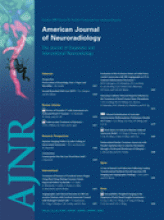Abstract
BACKGROUND AND PURPOSE: The combined automatic tube current modulation (ATCM) technique adapts and modulates the x-ray tube current in the x-y-z axis according to the patient's individual anatomy. We compared image quality and radiation dose of the combined ATCM technique with those of a fixed tube current (FTC) technique in craniocervical CT angiography performed with a 64-section multidetector row CT (MDCT) system.
MATERIALS AND METHODS: A retrospective review of craniocervical CT angiograms (CTAs) by using combined ATCM (n = 25) and FTC techniques (n = 25) was performed. Other CTA parameters, such as kilovolt (peak), matrix size, FOV, section thickness, pitch, contrast agent, and contrast injection techniques, were held constant. We recorded objective image noise in the muscles at 2 anatomic levels: radiation exposure doses (CT dose index volume and dose-length product); and subjective image quality parameters, such as vascular delineation of various arterial vessels, visibility of small arterial detail, image artifacts, and certainty of diagnosis. The Mann-Whitney U test was used for statistical analysis.
RESULTS: No significant difference was detected in subjective image quality parameters between the FTC and combined ATCM techniques. Most subjects in both study groups (49/50, 98%) had acceptable subjective artifacts. The objective image noise values at shoulder level did not show a significant difference, but the noise value at the upper neck was higher with the combined ATCM (P < .05) technique. Significant reduction in radiation dose (18% reduction) was noted with the combined ATCM technique (P < .05).
CONCLUSIONS: The combined ATCM technique for craniocervical CTA performed at 64-section MDCT substantially reduced radiation exposure dose but maintained diagnostic image quality.
- Copyright © American Society of Neuroradiology












